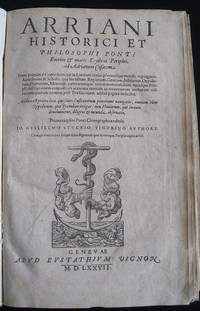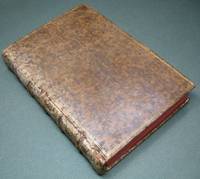
Peripilus Ponti Euxini & Maris Erthræi. Historici et Philosophi Ponti Euxini & Maris Erythræi Periplus, ad Adrianum Caesarem..
by Arrian of Nicomedia; Io Guilielmo Stuckio
- Used
- Hardcover
- first
- Condition
- See description
- Seller
-
Nafplion, Greece
Payment Methods Accepted
About This Item
Classical Authors: Genevæ- Geneva/ Lugduni- Lyon Euststhium Vignon / Bartholemæum Vincentium. 1577. [4] map[8] pp109 [12.]Blank; &: [8][10] pp109 [2][6]. First separate edition of works attributed to Arrian of Nicodemia which appeared simultaneously at Geneva and Lyons in 1577 with the translation and commentary of Johann Wilhem Stucki. This example has the Geneva imprint of the Ponti Euxini and the Lyons imprint of the Maris Erythræi. The texts of both works were first published by Froben in 1533 in the anthology Arriani & Hannonis periplus. Plutarchus de fluminibus & montibus. Strabonis epitome. The woodcut map of the Black Sea is the first printed map of the sea, it is decorated with ships, monsters and mermen. The Peripilus Ponti Euxini takes the form of a letter, from Arrian to the Emperor Hadrian in Rome, who was particularly attached to geographical research and had visited in person a large portion of his extensive dominions. It contains an accurate topographical survey of the coasts of the Euxine (Black Sea), from Trapezus to Byzantium, and was written probably while Arrian held his office of legate of Cappadocia, a short time before war broke out against the Alani; and it was doubtless at the same time that he drew up his instructions for the march of the Roman army against the barbarians, which are found in a short but imperfect fragment annexed to the Techne Taktika, written, as he states himself, in the twentieth year of the reign of the emperor, and containing, after a brief account of former writers on the same subject, a description of the order and arrangement of an army in general. Its purpose was to inform the emperor of the "lay of the land" and provide him with necessary information such as the distances between cities and the locations that would provide safe harbor for ships in a storm in the eventuality that Hadrian should mount a military expedition to the region. According to Gibbon's epigrammatic expression in his 42nd chapter, the Periplus contains "whatever the governor of Cappadocia had seen from Trebizond to Dioscurias; whatever he had heard, from Dioscurias to the Danube; and whatever he knew, from the Danube to Trebizond." Thus, while Arrian gives much information upon the south and east side of the Euxine, in going round the north shore his intervals become greater, and his measurements less precise. The second work the Periplus Maris Erythræi though for many years attributed to Arrian is now believed to be by an unknown author. The text has been ascribed to different dates between the 1st and 3rd centuries AD, but a mid-1st century date is now the most commonly accepted. A Greco-Roman periplus, written in Greek, describing navigation and trading opportunities from Roman Egyptian ports like Berenice along the coast of the Red Sea, and others along Northeast Africa and the Sindh and South western India, it is clearly a firsthand description by someone familiar with the area and is nearly unique in providing accurate insights into what the ancient European world knew about the lands around the Indian Ocean. One historical analysis, published by Schoff in 1912, narrowed the date of the text to 60 AD Though redating the document from 1912 to a single year roughly 2000 years earlier might be considered remarkable by modern standards, a date of 60 AD nevertheless remains in perfect agreement with present-day estimates of the middle of the 1st century AD .Schoff additionally provides an historical analysis as to the text's original authorship,and arrives at the conclusion that the author must have been a "Greek in Egypt, a Roman subject." By Schoff's calculations, this would have been during the time of Tiberius Claudius Balbilus (who coincidentally also was an Egyptian Greek). John Hill maintains that the "Periplus can now be confidently dated to between 40 and 70 AD and, probably, between AD 40 and 50." Schoff continues by noting that the author could not have been "a highly educated man" as "is evident from his frequent confusion of Greek and Latin words and his clumsy and sometimes ungrammatical constructions." Because of "the absence of any account of the journey up the Nile and across the desert from Coptos," Schoff prefers to pinpoint the author's residence to "Berenice rather than Alexandria." Though Schoff is unclear about which of several Berenices he is referring to, it is actually Berenice Troglodytica which is documented, discussed at length and vividly described within the periplus text itself. One peculiarity noted by Schoff while translating from the original Greek version is that "the text is so vague and uncertain that [the author] seems rather to be quoting from someone else, unless indeed much of this part of the work has been lost in copying." Contemporary vellum; blindstamped gilt to spine; title in ink. Ex Libris of R.H. Robbins to pastedown. Decorative printer's mark to titles. Folding double page woodcut map. Light toning to Part 1; waterstain to lower gutter p187 to p47 of second work, lightening and reappearing p69 to end. Pages 25-41 of second work with spotting, index toned. rear internal hinge starting. First printed woodcut map of the Black sea; folded. Arrian of Nicomedia (c.86/89 –146/160 AD Latin: Lucius Flavius Arrianus, was a Greek historian, public servant, military commander and philosopher of the Roman period. All we know of Arrian is derived from the notice of him in the "Bibliotheca" of Photius, who was Patriarch of Constantinople in the ninth century, and from a few incidental references in his own writings. We learn from Suidas that Dio Cassius wrote a biography of Arrian; but this work is not extant. Flavius Arrianus was born near the end of the first century of the Christian era, at Nicomedia, the capital of Bithynia. He became a pupil of the famous Stoic philosopher Epictetus, at Nicopolis, in Epirus and afterwards went to Athens, where he received the surname of the "younger Xenophon," from the fact that he occupied the same relation to Epictetus as Xenophon did to Socrates.' During the stay of the emperor Hadrian at Athens, A.D. 126, Arrian gained his friendship. He accompanied his patron to Rome, where he received the Roman citizenship. In consequence of this, he assumed the name of Flavius. In the same way the Jewish historian, Josephus, had been allowed by Vespasian and Titus to bear the imperial name Flavius. Photius says, that Arrian had a distinguished career in Rome, being intrusted with various political offices, and at last reaching the supreme dignity of consul under Antoninus Pius. Previous to this he was appointed (A.D. 132) by Hadrian, Governor of Cappadocia, which province was soon after invaded by the Alani, or Massagetae, whom he defeated and expelled When Marcus Aurelius came to the throne, Arrian withdrew into private life and returned to his native city, Nicomedia. Here, according to Photius, he was appointed priest to Demeter and Persephone. He died in the reign of Marcus Aurelius. The early literary efforts of Arrian were philosophical. including publishing the Discourses of Epictetus and the Encheiridion of Epictetus Besides editing these philosophical works, Arrian wrote many original books. By far the most important of these is the Anabasis of Alexander, or the History of Alexander the Great's Campaigns. This is one of the most authentic and accurate of historical works. Though inspired with admiration for his hero, the author evinces impartiality and freedom from hero-worship. He exhibits great literary acuteness in the choice of his authorities and in sifting evidence. The two chief sources from which he drew his narrative were the histories written by Ptolemy, son of Lagus, and Aristobulus, son of Aristobulus, both of whom were officers in Alexander's army. Indica, is a description of India, and an account of the voyage of Nearchus, and was usually united in manuscripts with the Anabasis, as an eighth book. A valuable geographical work by Arrian has come down to us, a description of a voyage round the coasts of the Euxine. This naval expedition was executed by him as Governor of Cappadocia. The Alani, or Albani of the East, a tribe related to the Massagetae, were threatening to invade his province, and he made this voyage with a view of fortifying the most important strategic points on the coast. From section 17 of the Periplus 1 we find that this voyage must have taken place about the year 131 or 132 A.D.; for the death of King Cotys II., noticed in that passage as just dead, is proved by Böckh's investigations to have occurred in 131 A.D [LIFE AND WRITINGS OF ARRIAN.from E.J Chinnock, 1893] Johannes Guilelmus Stuckius- Johann Wilhelm Stucki; 1542-1607 Swiss Humanist , Academic and Author. Calvenist , who studied at Zurich Lausanne Strassburg and Paris. Whilst in Paris became involved in the religious controversies there and acted as interpreter for Pietro Vermigli (Peter Martyr) at the Debate of Poissey 1561. On his return to Zurich he was appointed professor at Collegium Carolinium 1569-71 and thereafter as Professor of Old Testament theology at Zurich till his death in 1607. His published his translation and commentaryof Arrian in 1577 in Geneva and Lyon. He would also publish a discussion of the rites and customs of the ancient Hebrews, Greeks, romans and other nations Antiquitatum convivialium libri III in 1582 and Sacorum sacrificiorumque brevis accurata descriptio in 1595. [Greek Authors- Arrianus Flavius by Philip A, Stadter, University of North Carolina at Chapel Hill] Graesse1 p228; Brunet 1 p497;Adams A 2016. Classical Authors Geography- Travels Black Sea Ponti Euxini Red Sea Maris Erythraei
Reviews
(Log in or Create an Account first!)
Details
- Bookseller
- Mary Louise Bryan/Paralos Gallery
(GR)
- Bookseller's Inventory #
- 2988
- Title
- Peripilus Ponti Euxini & Maris Erthræi. Historici et Philosophi Ponti Euxini & Maris Erythræi Periplus, ad Adrianum Caesarem..
- Author
- Arrian of Nicomedia; Io Guilielmo Stuckio
- Book Condition
- Used
- Binding
- Hardcover
- Publisher
- Genevæ- Geneva/ Lugduni- Lyon Euststhium Vignon / Bartholemæum Vincentium. 1577
- Place of Publication
- Classical Authors
Terms of Sale
Mary Louise Bryan/Paralos Gallery
30 day return guarantee, with full refund including original shipping costs for up to 30 days after delivery if an item arrives misdescribed or damaged.
About the Seller
Mary Louise Bryan/Paralos Gallery
Biblio member since 2013
Nafplion
About Mary Louise Bryan/Paralos Gallery
Dealer in Antiquarian Maps Prints & Books with over 25 years experience. Shop in Historic centre of Nafplion Greece; Internet site Exhibiter at London Map Fair and at fairs around Europe. Member of the Antiquarian Booksellers Association & ILAB
Glossary
Some terminology that may be used in this description includes:
- Gilt
- The decorative application of gold or gold coloring to a portion of a book on the spine, edges of the text block, or an inlay in...
- Gutter
- The inside margin of a book, connecting the pages to the joints near the binding.
- Hinge
- The portion of the book closest to the spine that allows the book to be opened and closed.








![ΠΟΛΥΒΙΟΥ ΜΕΓΑΛΟΠΟΛΙΤ ΟΥ ΙΣΤΟΡΙΩΝ ΒΙ ΒΛΙΑΕ. Historiarum libri quinq[ue]. ΠΟΛΥΒΙΟΥ ΜΕΓΑΛΟΠΟΛΙΤ ΟΥ ΙΣΤΟΡΙΩΝ ΒΙ ΒΛΙΑΕ Historiarum libri quinq , opera Vincentiii Obsopoei in lucem editi. Iidem Latini Nicolao Perotto Episcopo Sipontino Interprete.](https://d3525k1ryd2155.cloudfront.net/h/099/475/927475099.0.m.jpg)
![A CHRONICLE OF THE KINGS OF ENGLAND From the Time of the Romans Government [sic] unto the Raigne of our Soveraigne Lord King Charles.](https://d3525k1ryd2155.cloudfront.net/h/269/385/956385269.0.m.jpg)

